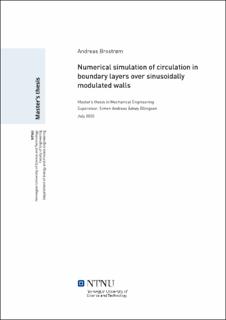| dc.contributor.advisor | Ellingsen, Simen Andreas Ådnøy | |
| dc.contributor.advisor | Simonsen, Are | |
| dc.contributor.author | Brostrøm, Andreas | |
| dc.date.accessioned | 2021-09-20T16:51:02Z | |
| dc.date.available | 2021-09-20T16:51:02Z | |
| dc.date.issued | 2020 | |
| dc.identifier | no.ntnu:inspera:57317709:20931751 | |
| dc.identifier.uri | https://hdl.handle.net/11250/2779651 | |
| dc.description.abstract | Skjærstrømninger over sinusoidalt modulerte vegger har vist å produsere roterende strømninger i et fluid i form av sirkulerende cellepar med motsatt roterende retning. Cellenes roterende akse er parallell med strømningsretningen til fluidet. Disse cellene er dynamisk ekvivalente til Langmuirsirkulasjoner, som er roterende cellestrukturer som kan oppstå under vannoverflaten i nærvær av bølger og vind over overflaten. Cellestrukturene har blitt observert til å bli ustabile for tilstrekkelig høye Reynoldstall. Hovedformålet med denne avhandlingen har vært å utvikle en CFD-modell i OpenFOAM 7 for å studere den transiente utviklingen av sirkulasjonscellene når de går fra stabile til ustabile. For å oppnå dette, blir de følgende forskningsspørsmålene definert:
- På hvilken måte utvikler sirkulasjonscellene seg til å bli ustabile?
- Hva er tidsskalaen for at sirkulasjonscellene skal brytes ned?
- Hvordan påvirker forskjellige strømnings- og domeneparametre instabiliteten til cellene?
En volumkraftdrevet skjærstrømning mellom speilede, tredimensjonale sinusoidale vegger er betraket for å modellere problemet. Resultater viser at Langmuirsirkulasjonscellene brytes ned ved at ytteligere sirkulasjonscellepar oppstår på linje med toppene og bunnene av de bølgete veggene. Disse cellestrukturene har motsatt rotasjonsretning sammenliknet med de originale cellene. Når de originale cellene har forsvunnet, blir de nye cellestrukturene ustabile, og viser tegn på overgang til turbulens. Tidsskalaen for at cellestrukturene skal brytes ned vises å være treg, og strømningen har beveget seg tilnærmet 120 ganger gjennom det periodiske domenet med tre veggperioder i strømningsretningen før de originale strukturene har forsvunnet fullstendig.
For å svare på det siste forskningsspørsmålet, har en parameterstudie blitt gjennomført, hvor det nominelle vegg-Reynoldstallet og den maksimale bølgekrappheten i strømningsretningen blir variert systematisk. Resultater fra parameterstudien viser at en reduksjon av vegg-Reynoldstall virker stabiliserende på sirkulasjonscellene. En økning i vegg-Reynoldstallet fører til en raskere nedbrytning av cellene, og også en tidligere overgang fra fullt laminær strømning. Ved å minke bølgekrappheten bølgekrappheten tilstrekkelig, vises det at strømingen blir stasjonær og at de regulære strukturene i sirkulasjonscellene forblir. Økning av bølgekrappheten akselererer nedbrytningen av Langmuircellene, og også overgangen til turbulent oppførsel i strømningen. | |
| dc.description.abstract | Shear flows over sinusoidally modulated boundary walls are known to produce rotational currents in the fluid, in the form of circulation cell pairs with opposite rotational direction. The rotational axis of the cells are parallel to the streamwise direction of the flow. These cells are dynamically equivalent to Langmuir Circulations, which are rotational cell structures that may form under a water surface in the presence of waves and wind above the surface. These rotational structures are observed to become unstable for sufficiently high Reynolds numbers. The main objective of the thesis work has been to develop a CFD model in OpenFOAM 7 for studying the transient development of the circulation cells when the flow goes from stable to unstable. To accomplish this, the following research questions are defined:
- In what way does the circulation cells evolve to become unstable?
- What is the time scale for the circulation cells to break down?
- How does different flow and domain parameters affect the instability of the cells?
\noindent A body force driven shear flow between mirrored, three dimensional sinusoidal walls is considered to model the problem. Results show that the Langmuir Circulation cells breaks down due to the formation of additional circulation cell pairs in line with the peaks and troughs of the wavy wall boundaries. The additional cell structures have the opposite rotational direction compared to the original cells. When the original cells have disappeared, the new cell structures becomes unstable, and the flow shows signs of transitioning to turbulence. The time scale of the cell structure break down is shown to be slow, and the flow has travelled trough the periodic domain of three streamwise wall periods approximately 120 times before the original structures have vanished completely.
To answer the final research question, a parameter study is performed, where the nominal friction Reynolds number and the maximum streamwise wall wave steepness are varied systematically. Results from the parameter study shows that the decrease in friction Reynolds number acts stabilising on the circulation cells. Increasing the friction Reynolds number causes a more rapid break down of the cells, and also earlier transitioning away from a fully laminar flow. By sufficiently decreasing the wave steepness wave steepness, the flow is shown to become steady and the regular structure of the circulation cells is kept. Increasing wave steepness accelerates the break down of the Langmuir cells, and also the transition to turbulent flow behaviour. | |
| dc.language | | |
| dc.publisher | NTNU | |
| dc.title | Numerical simulation of circulation in boundary layers over sinusoidally modulated walls | |
| dc.type | Master thesis | |
